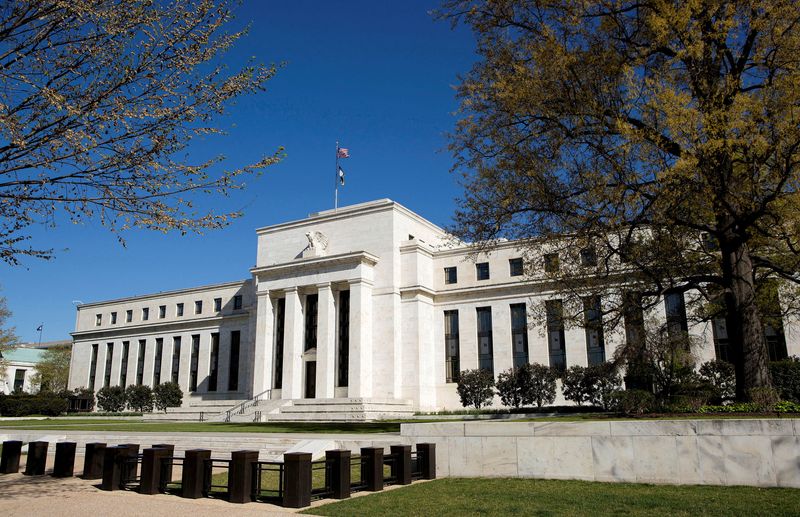By Yoruk Bahceli
(Reuters) - Government borrowing costs across developed economies saw their biggest jumps in months in April, evidence that bond markets are not yet out of the woods when it comes to inflation and the threat of higher-for-longer than expected interest rates.
U.S. inflation jumping the most in six months sent two-year Treasury yields above 5% in April as traders slashed Federal Reserve rate cut bets.
Benchmark 10-year U.S. yields, up over 40 basis points (bps) at 4.6% in their biggest move since September when fiscal worries mounted, could also hit 5% soon, some investors reckon. Bond yields move inversely to prices.
In Europe, German 10-year bond yields have crossed the closely-watched 2.5% technical level. Britain's rose nearly 40 bps in their biggest monthly jump since May.
Ed Hutchings, head of rates at Aviva (LON:AV) Investors, said that without U.S. economic data cooling, it was hard to bet with conviction that bond yields would fall.
"Until the data turns, investors are going to want a little bit of extra compensation to own government bonds," he said.
Hutchings has favoured shorter-dated euro zone and UK debt over Treasuries, but noted U.S. yields had pulled European peers higher.
Global government bonds have lost investors 2.5% so far this year. That risks leaving 2023's modest return looking like a blip after 15% losses over 2021-22, when surging inflation surprised markets and policymakers.
The latest moves highlight market sensitivity to inflation even as it slows from double-digit levels in 2022.
EUROPE TOO
Traders have also curbed European rate cut expectations, adding to the bond selloff.
They expect just 40 bps of Bank of England cuts this year, down from around 70 bps in late March, and around 70 bps from the European Central Bank, down from 90 bps in early April .
While the repricing of Fed rate cut expectations prompted much of those moves, investors have also reacted to data this month showing British inflation and wage growth slowed less than expected. Dovish, followed by hawkish BoE policymaker commentary also moved expectations.
British and euro zone business activity meanwhile rose more than expected, at the fastest paces in nearly a year, pointing to strengthening economies, also confirmed by the euro zone growing more than expected in the first quarter.
"You need to have a high degree of conviction in your models that in a slowing inflation environment with strong economic activity, inflation isn't flaring up again," said Danske Bank chief analyst Piet Christiansen.
Many investors favour euro zone bonds, which have outperformed as inflation nearing the ECB's 2% target paves the way for rate cuts expected to start in June.
Data on Tuesday showed inflation at 2.4% in April, as expected. The closely-watched services measure slowed for the first time in months, though core inflation dropped less than expected.
Yet ECB policymakers have sounded cautious about cuts beyond June.
"The (business activity) data coming in is questioning how many rate cuts are needed after the June cut," Christiansen said.
In another sign of caution, a market gauge of euro zone inflation expectations watched by the ECB touched its highest since December around 2.4% as oil prices rose.
The UK debt outlook is more uncertain. A Reuters poll of economists expects 75 bps of BoE rate cuts by year-end, nearly double what markets price.
If traders' BoE expectations recover, that would favour Britain's debt. Goldman Sachs (NYSE:GS) recommends buying 30-year gilts over Treasuries.
But high funding needs would limit how much longer-dated gilt yields could fall, Imogen Bachra, head of non-dollar rates strategy at NatWest Markets, said in a note on Monday, even as she expects 100 bps of cuts this year.
Gilts have underperformed global government bonds even as inflation slows, losing investors over 4% year-to-date.
BONDS STILL BACK?
To be sure, investors say bonds remain appealing given the attractive yields they pay longer-term holders after spending a decade at or below 0%.
Case in point: Britain saw the third-highest ever level of demand on record for a 30-year bond sold at a record yield.
Some investors said their dampening impact on the economy would limit how much further U.S. bond yields, which determine other borrowing costs, could rise.
"I suspect that just as investors were too complacent a few months ago on inflation and rates, the reverse is true currently and we will see bond yields moderate somewhat," said Zurich Insurance Group's chief market strategist Guy Miller.

U.S. economic uncertainty is expected to keep global markets volatile.
"The market is doing some probability weighted outcome of no cuts, some cuts, and maybe a very small tail of more cuts down the road," said Idanna Appio, fund manager at First Eagle Asset Management and a former Fed economist.